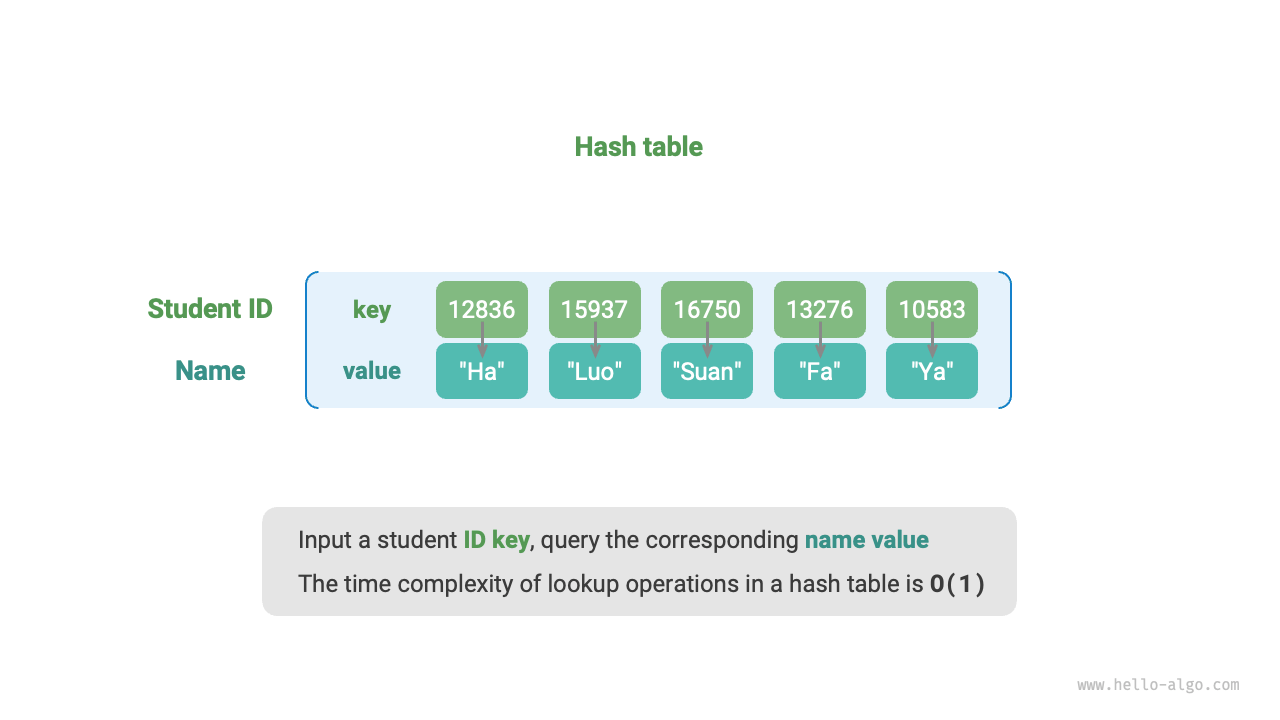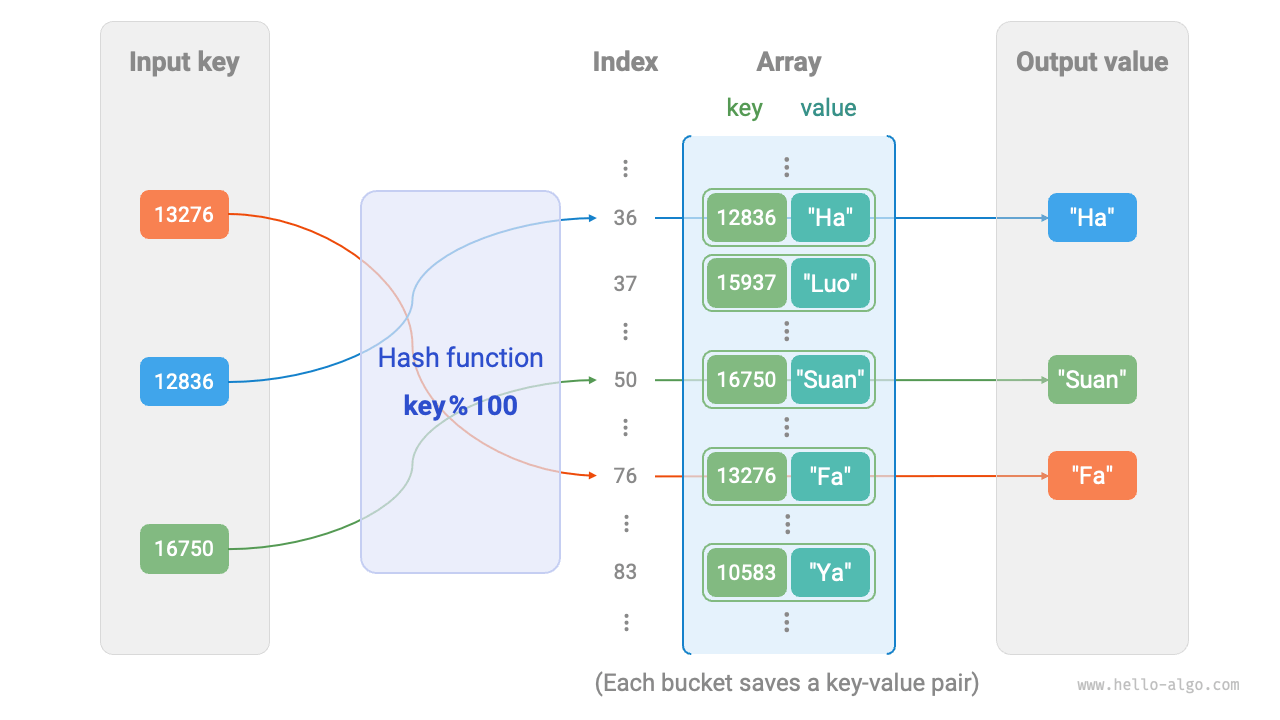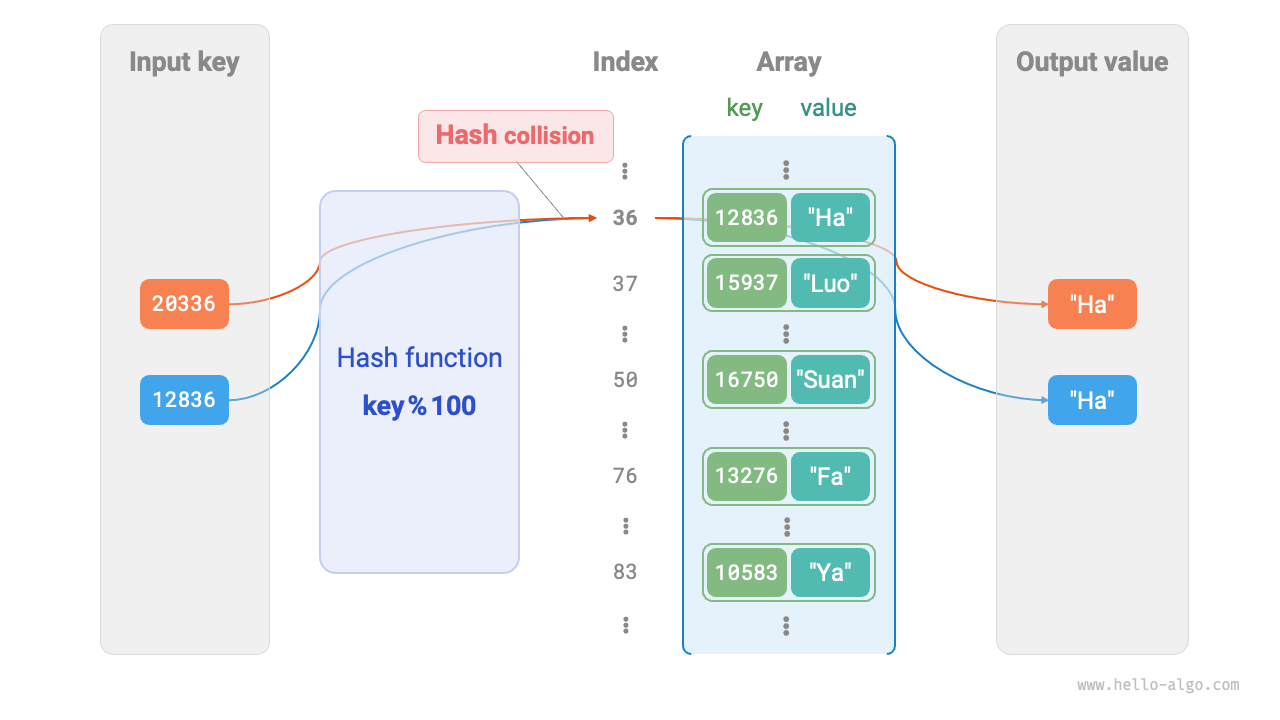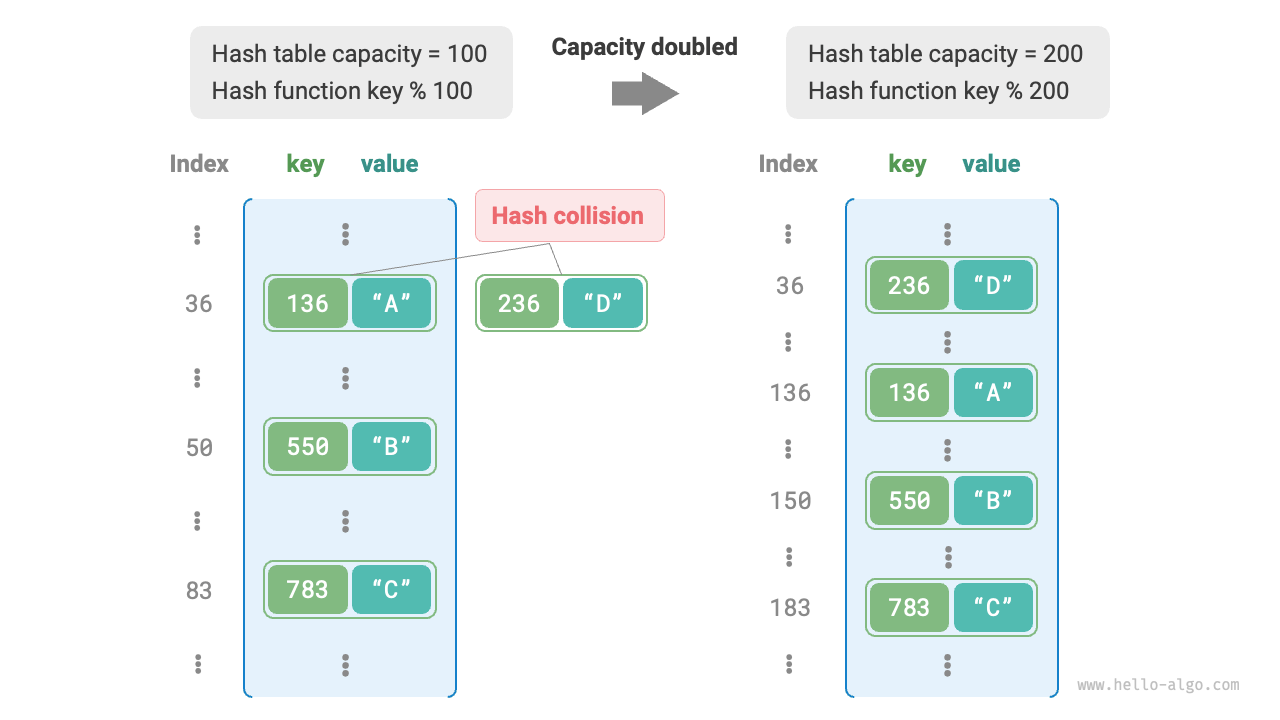6.1 Hash table¶
A hash table, also known as a hash map, is a data structure that establishes a mapping between keys and values, enabling efficient element retrieval. Specifically, when we input a key into the hash table, we can retrive the corresponding value in \(O(1)\) time complexity.
As shown in Figure 6-1, given \(n\) students, each student has two data fields: "Name" and "Student ID". If we want to implement a query function that takes a student ID as input and returns the corresponding name, we can use the hash table shown in Figure 6-1.
Figure 6-1 Abstract representation of a hash table
In addition to hash tables, arrays and linked lists can also be used to implement query functionality, but the time complexity is different. Their efficiency is compared in Table 6-1:
- Inserting elements: Simply append the element to the tail of the array (or linked list). The time complexity of this operation is \(O(1)\).
- Searching for elements: As the array (or linked list) is unsorted, searching for an element requires traversing through all of the elements. The time complexity of this operation is \(O(n)\).
- Deleting elements: To remove an element, we first need to locate it. Then, we delete it from the array (or linked list). The time complexity of this operation is \(O(n)\).
Table 6-1 Comparison of time efficiency for common operations
| Array | Linked List | Hash Table | |
|---|---|---|---|
| Search Elements | \(O(n)\) | \(O(n)\) | \(O(1)\) |
| Insert Elements | \(O(1)\) | \(O(1)\) | \(O(1)\) |
| Delete Elements | \(O(n)\) | \(O(n)\) | \(O(1)\) |
It can be seen that the time complexity for operations (insertion, deletion, searching, and modification) in a hash table is \(O(1)\), which is highly efficient.
6.1.1 Common operations of hash table¶
Common operations of a hash table include: initialization, querying, adding key-value pairs, and deleting key-value pairs. Here is an example code:
# Initialize hash table
hmap: dict = {}
# Add operation
# Add key-value pair (key, value) to the hash table
hmap[12836] = "Xiao Ha"
hmap[15937] = "Xiao Luo"
hmap[16750] = "Xiao Suan"
hmap[13276] = "Xiao Fa"
hmap[10583] = "Xiao Ya"
# Query operation
# Input key into hash table, get value
name: str = hmap[15937]
# Delete operation
# Delete key-value pair (key, value) from hash table
hmap.pop(10583)
/* Initialize hash table */
unordered_map<int, string> map;
/* Add operation */
// Add key-value pair (key, value) to the hash table
map[12836] = "Xiao Ha";
map[15937] = "Xiao Luo";
map[16750] = "Xiao Suan";
map[13276] = "Xiao Fa";
map[10583] = "Xiao Ya";
/* Query operation */
// Input key into hash table, get value
string name = map[15937];
/* Delete operation */
// Delete key-value pair (key, value) from hash table
map.erase(10583);
/* Initialize hash table */
Map<Integer, String> map = new HashMap<>();
/* Add operation */
// Add key-value pair (key, value) to the hash table
map.put(12836, "Xiao Ha");
map.put(15937, "Xiao Luo");
map.put(16750, "Xiao Suan");
map.put(13276, "Xiao Fa");
map.put(10583, "Xiao Ya");
/* Query operation */
// Input key into hash table, get value
String name = map.get(15937);
/* Delete operation */
// Delete key-value pair (key, value) from hash table
map.remove(10583);
/* Initialize hash table */
Dictionary<int, string> map = new() {
/* Add operation */
// Add key-value pair (key, value) to the hash table
{ 12836, "Xiao Ha" },
{ 15937, "Xiao Luo" },
{ 16750, "Xiao Suan" },
{ 13276, "Xiao Fa" },
{ 10583, "Xiao Ya" }
};
/* Query operation */
// Input key into hash table, get value
string name = map[15937];
/* Delete operation */
// Delete key-value pair (key, value) from hash table
map.Remove(10583);
/* Initialize hash table */
hmap := make(map[int]string)
/* Add operation */
// Add key-value pair (key, value) to the hash table
hmap[12836] = "Xiao Ha"
hmap[15937] = "Xiao Luo"
hmap[16750] = "Xiao Suan"
hmap[13276] = "Xiao Fa"
hmap[10583] = "Xiao Ya"
/* Query operation */
// Input key into hash table, get value
name := hmap[15937]
/* Delete operation */
// Delete key-value pair (key, value) from hash table
delete(hmap, 10583)
/* Initialize hash table */
var map: [Int: String] = [:]
/* Add operation */
// Add key-value pair (key, value) to the hash table
map[12836] = "Xiao Ha"
map[15937] = "Xiao Luo"
map[16750] = "Xiao Suan"
map[13276] = "Xiao Fa"
map[10583] = "Xiao Ya"
/* Query operation */
// Input key into hash table, get value
let name = map[15937]!
/* Delete operation */
// Delete key-value pair (key, value) from hash table
map.removeValue(forKey: 10583)
/* Initialize hash table */
const map = new Map();
/* Add operation */
// Add key-value pair (key, value) to the hash table
map.set(12836, 'Xiao Ha');
map.set(15937, 'Xiao Luo');
map.set(16750, 'Xiao Suan');
map.set(13276, 'Xiao Fa');
map.set(10583, 'Xiao Ya');
/* Query operation */
// Input key into hash table, get value
let name = map.get(15937);
/* Delete operation */
// Delete key-value pair (key, value) from hash table
map.delete(10583);
/* Initialize hash table */
const map = new Map<number, string>();
/* Add operation */
// Add key-value pair (key, value) to the hash table
map.set(12836, 'Xiao Ha');
map.set(15937, 'Xiao Luo');
map.set(16750, 'Xiao Suan');
map.set(13276, 'Xiao Fa');
map.set(10583, 'Xiao Ya');
console.info('\nAfter adding, the hash table is\nKey -> Value');
console.info(map);
/* Query operation */
// Input key into hash table, get value
let name = map.get(15937);
console.info('\nInput student number 15937, query name ' + name);
/* Delete operation */
// Delete key-value pair (key, value) from hash table
map.delete(10583);
console.info('\nAfter deleting 10583, the hash table is\nKey -> Value');
console.info(map);
/* Initialize hash table */
Map<int, String> map = {};
/* Add operation */
// Add key-value pair (key, value) to the hash table
map[12836] = "Xiao Ha";
map[15937] = "Xiao Luo";
map[16750] = "Xiao Suan";
map[13276] = "Xiao Fa";
map[10583] = "Xiao Ya";
/* Query operation */
// Input key into hash table, get value
String name = map[15937];
/* Delete operation */
// Delete key-value pair (key, value) from hash table
map.remove(10583);
use std::collections::HashMap;
/* Initialize hash table */
let mut map: HashMap<i32, String> = HashMap::new();
/* Add operation */
// Add key-value pair (key, value) to the hash table
map.insert(12836, "Xiao Ha".to_string());
map.insert(15937, "Xiao Luo".to_string());
map.insert(16750, "Xiao Suan".to_string());
map.insert(13279, "Xiao Fa".to_string());
map.insert(10583, "Xiao Ya".to_string());
/* Query operation */
// Input key into hash table, get value
let _name: Option<&String> = map.get(&15937);
/* Delete operation */
// Delete key-value pair (key, value) from hash table
let _removed_value: Option<String> = map.remove(&10583);
Code Visualization
There are three common ways to traverse a hash table: traversing key-value pairs, traversing keys, and traversing values. Here is an example code:
/* Traverse hash table */
// Traverse key-value pairs key->value
for (auto kv: map) {
cout << kv.first << " -> " << kv.second << endl;
}
// Traverse using iterator key->value
for (auto iter = map.begin(); iter != map.end(); iter++) {
cout << iter->first << "->" << iter->second << endl;
}
/* Traverse hash table */
// Traverse key-value pairs key->value
for (Map.Entry<Integer, String> kv: map.entrySet()) {
System.out.println(kv.getKey() + " -> " + kv.getValue());
}
// Traverse keys only
for (int key: map.keySet()) {
System.out.println(key);
}
// Traverse values only
for (String val: map.values()) {
System.out.println(val);
}
/* Traverse hash table */
// Traverse key-value pairs Key->Value
foreach (var kv in map) {
Console.WriteLine(kv.Key + " -> " + kv.Value);
}
// Traverse keys only
foreach (int key in map.Keys) {
Console.WriteLine(key);
}
// Traverse values only
foreach (string val in map.Values) {
Console.WriteLine(val);
}
/* Traverse hash table */
console.info('\nTraverse key-value pairs Key->Value');
for (const [k, v] of map.entries()) {
console.info(k + ' -> ' + v);
}
console.info('\nTraverse keys only Key');
for (const k of map.keys()) {
console.info(k);
}
console.info('\nTraverse values only Value');
for (const v of map.values()) {
console.info(v);
}
/* Traverse hash table */
console.info('\nTraverse key-value pairs Key->Value');
for (const [k, v] of map.entries()) {
console.info(k + ' -> ' + v);
}
console.info('\nTraverse keys only Key');
for (const k of map.keys()) {
console.info(k);
}
console.info('\nTraverse values only Value');
for (const v of map.values()) {
console.info(v);
}
Code Visualization
6.1.2 Simple implementation of a hash table¶
First, let's consider the simplest case: implementing a hash table using only one array. In the hash table, each empty slot in the array is called a bucket, and each bucket can store a key-value pair. Therefore, the query operation involves finding the bucket corresponding to the key and retrieving the value from it.
So, how do we locate the corresponding bucket based on the key? This is achieved through a hash function. The role of the hash function is to map a larger input space to a smaller output space. In a hash table, the input space consists of all the keys, and the output space consists of all the buckets (array indices). In other words, given a key, we can use the hash function to determine the storage location of the corresponding key-value pair in the array.
When given a key, the calculation process of the hash function consists of the following two steps:
- Calculate the hash value by using a certain hash algorithm
hash(). - Take the modulus of the hash value with the bucket count (array length)
capacityto obtain the arrayindexcorresponding to that key.
Afterward, we can use the index to access the corresponding bucket in the hash table and thereby retrieve the value.
Let's assume that the array length is capacity = 100, and the hash algorithm is defined as hash(key) = key. Therefore, the hash function can be expressed as key % 100. The following figure illustrates the working principle of the hash function using key as student ID and value as name.
Figure 6-2 Working principle of hash function
The following code implements a simple hash table. Here, we encapsulate key and value into a class Pair to represent the key-value pair.
class Pair:
"""Key-value pair"""
def __init__(self, key: int, val: str):
self.key = key
self.val = val
class ArrayHashMap:
"""Hash table based on array implementation"""
def __init__(self):
"""Constructor"""
# Initialize an array, containing 100 buckets
self.buckets: list[Pair | None] = [None] * 100
def hash_func(self, key: int) -> int:
"""Hash function"""
index = key % 100
return index
def get(self, key: int) -> str:
"""Query operation"""
index: int = self.hash_func(key)
pair: Pair = self.buckets[index]
if pair is None:
return None
return pair.val
def put(self, key: int, val: str):
"""Add operation"""
pair = Pair(key, val)
index: int = self.hash_func(key)
self.buckets[index] = pair
def remove(self, key: int):
"""Remove operation"""
index: int = self.hash_func(key)
# Set to None, representing removal
self.buckets[index] = None
def entry_set(self) -> list[Pair]:
"""Get all key-value pairs"""
result: list[Pair] = []
for pair in self.buckets:
if pair is not None:
result.append(pair)
return result
def key_set(self) -> list[int]:
"""Get all keys"""
result = []
for pair in self.buckets:
if pair is not None:
result.append(pair.key)
return result
def value_set(self) -> list[str]:
"""Get all values"""
result = []
for pair in self.buckets:
if pair is not None:
result.append(pair.val)
return result
def print(self):
"""Print hash table"""
for pair in self.buckets:
if pair is not None:
print(pair.key, "->", pair.val)
/* Key-value pair */
struct Pair {
public:
int key;
string val;
Pair(int key, string val) {
this->key = key;
this->val = val;
}
};
/* Hash table based on array implementation */
class ArrayHashMap {
private:
vector<Pair *> buckets;
public:
ArrayHashMap() {
// Initialize an array, containing 100 buckets
buckets = vector<Pair *>(100);
}
~ArrayHashMap() {
// Free memory
for (const auto &bucket : buckets) {
delete bucket;
}
buckets.clear();
}
/* Hash function */
int hashFunc(int key) {
int index = key % 100;
return index;
}
/* Query operation */
string get(int key) {
int index = hashFunc(key);
Pair *pair = buckets[index];
if (pair == nullptr)
return "";
return pair->val;
}
/* Add operation */
void put(int key, string val) {
Pair *pair = new Pair(key, val);
int index = hashFunc(key);
buckets[index] = pair;
}
/* Remove operation */
void remove(int key) {
int index = hashFunc(key);
// Free memory and set to nullptr
delete buckets[index];
buckets[index] = nullptr;
}
/* Get all key-value pairs */
vector<Pair *> pairSet() {
vector<Pair *> pairSet;
for (Pair *pair : buckets) {
if (pair != nullptr) {
pairSet.push_back(pair);
}
}
return pairSet;
}
/* Get all keys */
vector<int> keySet() {
vector<int> keySet;
for (Pair *pair : buckets) {
if (pair != nullptr) {
keySet.push_back(pair->key);
}
}
return keySet;
}
/* Get all values */
vector<string> valueSet() {
vector<string> valueSet;
for (Pair *pair : buckets) {
if (pair != nullptr) {
valueSet.push_back(pair->val);
}
}
return valueSet;
}
/* Print hash table */
void print() {
for (Pair *kv : pairSet()) {
cout << kv->key << " -> " << kv->val << endl;
}
}
};
/* Key-value pair */
class Pair {
public int key;
public String val;
public Pair(int key, String val) {
this.key = key;
this.val = val;
}
}
/* Hash table based on array implementation */
class ArrayHashMap {
private List<Pair> buckets;
public ArrayHashMap() {
// Initialize an array, containing 100 buckets
buckets = new ArrayList<>();
for (int i = 0; i < 100; i++) {
buckets.add(null);
}
}
/* Hash function */
private int hashFunc(int key) {
int index = key % 100;
return index;
}
/* Query operation */
public String get(int key) {
int index = hashFunc(key);
Pair pair = buckets.get(index);
if (pair == null)
return null;
return pair.val;
}
/* Add operation */
public void put(int key, String val) {
Pair pair = new Pair(key, val);
int index = hashFunc(key);
buckets.set(index, pair);
}
/* Remove operation */
public void remove(int key) {
int index = hashFunc(key);
// Set to null, indicating removal
buckets.set(index, null);
}
/* Get all key-value pairs */
public List<Pair> pairSet() {
List<Pair> pairSet = new ArrayList<>();
for (Pair pair : buckets) {
if (pair != null)
pairSet.add(pair);
}
return pairSet;
}
/* Get all keys */
public List<Integer> keySet() {
List<Integer> keySet = new ArrayList<>();
for (Pair pair : buckets) {
if (pair != null)
keySet.add(pair.key);
}
return keySet;
}
/* Get all values */
public List<String> valueSet() {
List<String> valueSet = new ArrayList<>();
for (Pair pair : buckets) {
if (pair != null)
valueSet.add(pair.val);
}
return valueSet;
}
/* Print hash table */
public void print() {
for (Pair kv : pairSet()) {
System.out.println(kv.key + " -> " + kv.val);
}
}
}
6.1.3 Hash collision and resizing¶
Essentially, the role of the hash function is to map the entire input space of all keys to the output space of all array indices. However, the input space is often much larger than the output space. Therefore, theoretically, there will always be cases where "multiple inputs correspond to the same output".
In the example above, with the given hash function, when the last two digits of the input key are the same, the hash function produces the same output. For instance, when querying two students with student IDs 12836 and 20336, we find:
As shown in Figure 6-3, both student IDs point to the same name, which is obviously incorrect. This situation where multiple inputs correspond to the same output is called hash collision.
Figure 6-3 Example of hash collision
It is easy to understand that as the capacity \(n\) of the hash table increases, the probability of multiple keys being assigned to the same bucket decreases, resulting in fewer collisions. Therefore, we can reduce hash collisions by resizing the hash table.
As shown in Figure 6-4, before resizing, the key-value pairs (136, A) and (236, D) collide. However, after resizing, the collision is resolved.
Figure 6-4 Hash table resizing
Similar to array expansion, resizing a hash table requires migrating all key-value pairs from the original hash table to the new one, which is time-consuming. Furthermore, since the capacity of the hash table changes, we need to recalculate the storage positions of all key-value pairs using the hash function, further increasing the computational overhead of the resizing process. Therefore, programming languages often allocate a sufficiently large capacity for the hash table to prevent frequent resizing.
The load factor is an important concept in hash tables. It is defined as the ratio of the number of elements in the hash table to the number of buckets. It is used to measure the severity of hash collisions and often serves as a trigger for hash table resizing. For example, in Java, when the load factor exceeds \(0.75\), the system will resize the hash table to twice its original size.



